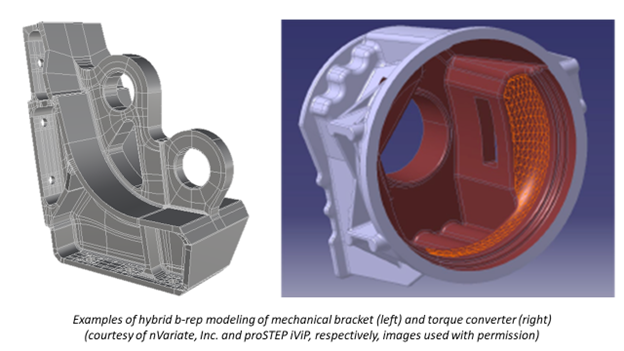NIST Contributes to New Modeling Capability in ISO Product Data Interoperability Standard

Credit: CTL
In January 2024, NIST researchers Allison Barnard Feeney and Rosemary Astheimer worked with Ben Urick (nVariate) and Thomas Thurman (TRThurman Consulting) to implement a hybrid boundary-representation (b-rep) modeling capability in ISO 10303 Product data representation and exchange, commonly known as STEP, a widely adopted standard for CAD/CAE and PDM data exchange, system integration, visualization, and long-term preservation of product information.
Hybrid b-rep modeling is a recent capability in CAD systems that offers formal integration of multiple sources and types of geometry into a single b-rep geometric model. These tools allow engineers to include facet geometry from the proliferation of applications producing facet data (topology-optimization, 3D scanning, reverse-engineering, etc.) with precise geometry in their 3D model and edit seamlessly, without the need for conversion. STEP hybrid b-rep modeling data structures support mappings to Polyhedral B-reps™ (Dassault Systèmes), Convergent B-reps™ (Siemens), Mixed Modeling (PTC onshape), etc. Facet data is defined by triangular meshes to approximate surfaces and is is best suited for digital mock-ups, gaming and animation. Precise or explicit geometry b-rep models are defined mathematically and represent highly accurate, closed (solid) volumes used in scenarios where high precision is needed, such as 3D modeling for engineering analysis, manufacturing, and inspection.
The foundation of the STEP representation is an explicitly defined topological model, a face-edge-vertex structure or equivalent, b-rep solid model. In contrast to traditional b-rep models where the referenced geometry must be of the same type of geometric representation item, the hybrid topological model relaxes that constraint and is agnostic to subtypes of geometric representation item and topological representation item. The new hybrid b-rep model:
- is consistent with geometric models and geometric model elements in ISO 10303-42 Geometric and topological modeling;
- is aligned with ISO 23952 Quality information frameworkhybrid geometric model; and
- supports modeling requirements for Isogeometric Analysis (IGA).
A planned extension to STEP hybrid b-rep modeling will support multiple sets of geometric references (in parallel) for a single b-rep topological model. This capability will enable multiple geometric digital twins of a product (engineering design, as-manufactured, as-inspected, for example) to be linked to the same topology.
The work was done under Working Group 12 STEP product modeling and resources, Team 1 Geometry and Topology (WG12/T1) of ISO Technical Committee 184 Automation Systems and Integration, Sub Committee 4 Industrial Data (ISO/TC 184/SC 4). This new capability is a common resource for any STEP application protocol that includes geometric modeling. It will appear first in ISO 10303-242 edition 4, Managed model-based 3D engineering, under Draft International Standard ballot this spring.
Legal Disclaimer:
EIN Presswire provides this news content "as is" without warranty of any kind. We do not accept any responsibility or liability for the accuracy, content, images, videos, licenses, completeness, legality, or reliability of the information contained in this article. If you have any complaints or copyright issues related to this article, kindly contact the author above.
